The best TVs for sound 2024: from Sony, Panasonic, Hisense and more
The best TVs for sound offer theater-style audio without adding any extra devices
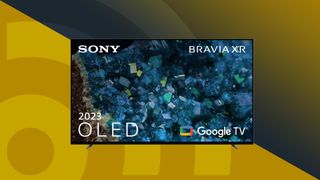
The best TVs for sound tend to come from Sony and Samsung globally, and that remains the case so far this year with both brands dominating our roundup of the best.
In Europe, Panasonic and Philips are also known for including full-strength sound systems in their flagship TVs, with powerful forward and upfiring drivers for Dolby Atmos. These TVs don't tend to get big sales season discounts, but many of the more mid-range models from other makers do, so keep your eyes open.
Matt Bolton, Managing Editor – Entertainment
The best TVs for sound deliver great picture quality and dynamic, room-filling sound to go with it. Although it might seem like as the picture performance of TVs advances, sound tends to suffer, there are a few excellent TVs on the market with a built-in sound system that'll blow you away.
As TVs have gotten thinner over the years, there is less space in the display’s physical frame for adding speakers. The end result—in some cases—has been sound that’s as thin as the TV itself. This makes hearing voices particularly difficult, especially when they are mixed with music soundtracks and movie sound effects.
So, even with many of the best TVs you can buy today, we highly recommend you invest in one of the best soundbars or the best surround sound systems. Of course, we also understand that going down that route requires more research—checking you have enough space and the right connections—and extra budget.
If you're looking to hit two targets with one arrow, however, know that there are also options for you. There are several TVs on the market that come with superb sound systems as standard, allowing you to get good sound quality with no extra gear or work necessary.
We've tested hundreds of TVs over the years, so we know what makes a great package. Rest assured, each of the TV displays on our list don't just sound good, they look fantastic and have much of the best TV tech built-in too. Whether it’s a Hollywood blockbuster or just back episodes of Friends, the TVs we've selected below will make sure that whatever you’re watching sounds as good as it can.
The best TV for sound for most people
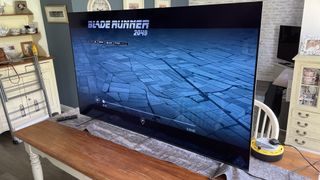
Specifications
Reasons to buy
Reasons to avoid
Sony has been at the forefront of putting good quality built-in audio to match the picture performance on its TVs for some time now, and the Sony A80L, its 2023 mid-range OLED, is no exception. Its built-in audio is direct, clear and creates a greater sense of immersion than most other TV's sound systems can.
The A80L uses what Sony calls Acoustic Surface Audio, which is where the A80L's speakers can pass sound 'through' the TV to give a more direct feel, which it succeeds at doing. Dialogue is also clear, something a lot built-in TV sound systems struggle with. Another area where the A80L excels is making the action on screen feel connected to the sound, even with Dolby Atmos soundtracks that further immerse you into the experience. The A80L's sound quality does lack in bass, despite two built-in subwoofers, but still beats nearly all other TVs.
But it's not just audio where the A80L impresses, as its picture quality is also top-notch. Details and textures are beautifully defined and sharp. In our review, we said "its color handling is mesmerizingly precise". It is sadly a little dimmer than other OLEDs, with a peak brightness of 800 nits, which is lower than the LG C3, but its overall picture is still fantastic.
There's also a host of gaming features here, but only two HDMI 2.1 ports and a basic VRR system – no AMD FreeSync or Nvidia G-Sync. It also has 'Perfect for PS5' tone mapping that will appeal to PS5 owners.
Although there are other TVs that have more powerful and immersive sound (we'll get into that below), the Sony A80L offers a brilliant built-in sound system for a competitive OLED price which may save you having to buy a soundbar and that's why it sits at the top of this list.
Read our full Sony A80L review
The best premium TV for sound in the UK
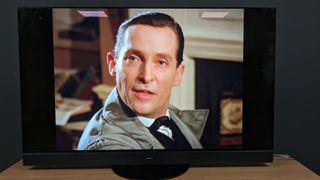
Specifications
Reasons to buy
Reasons to avoid
Panasonic, like Sony, has put just as much stock in audio quality as picture quality in its OLED TVs. The Panasonic MZ2000 has one of the most phenomenal built-in sound systems in a TV that you can buy, with a wide soundstage, multiple levels of sound cutomization and straightforward power.
The MZ2000 has an external bar at the bottom of the TV's frame that allows the front channels to breathe, giving them a more straightforward and direct approach. Its 5.1.2 speaker configuration totals 125W of power, which enables it to fill any room with ease. Everything is crisp and clean and with some setup, using the Space Tune setting to adjust the MZ2000's speakers to the room, you can make its sound profile truly phenomenal.
Dolby Atmos and surround sound is a breeze for the MZ2000, as we found in our tests with The Batman and Top Gun: Maverick. It truly took immersion to the next level for a built-in TV sound system, demonstrating that wide soundstage we mentioned before.
Picture quality is also staggering on the MZ2000. Textures are its strong suit, as everything feels natural, defined and detailed. Mix this with stunning HDR colors, rich contrast and superb black levels and you have a TV with a knockout picture. Not only that, but its upscaling of SDR and low-res sources is incredible too.
So why is the MZ2000 not the top of the list? It comes down to price. The Sony A80L is £500 cheaper, on average, than the MZ2000 in a 55-inch size and although the MZ2000's built-in sound is better, it's not that much better. Also, the MZ2000's smart TV platform is a flaw in its near-perfect build.
Sadly, the MZ2000 is also only available in the UK. If you have a premium budget and are in the UK though, the MZ2000 is tough to beat.
Read our full Panasonic MZ2000 review
The best premium TV for sound in the US
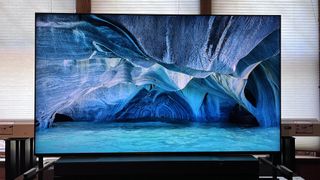
Specifications
Reasons to buy
Reasons to avoid
Many TVs use down-firing speakers located near the bottom of their frame. And while these handle the basic job of transmitting sound, both dialogue and effects with this design can seem disconnected from the on-screen action, and you rarely get a sense of spaciousness with Dolby Atmos soundtracks.
The Sony Bravia 9’s Acoustic Multi Audio+ design solves the problem of disconnected TV sound by using tweeters installed in the left and right sides of the TV’s frame. These work to elevate dialogue so it sounds like it’s coming directly from the mouths of characters talking onscreen, and they also make the positioning of sound effects accurate and natural. And in contrast to the virtual Atmos processing used by most TVs, the Bravia 9 has ’“Beam” drivers located on top that create a real sense of spaciousness by bouncing sound off your room’s ceiling.
The Bravia 9’s 2.2.2-channel speaker system is powered by 70 watts and supports Dolby Atmos and DTS:X immersive soundtracks. 3D Surround Upscaling adds spaciousness to regular stereo or mono soundtracks, and a feature called Voice Zoom 3 uses AI to isolate dialogue and boost it separately to enhance the clarity of voices.
Another feature, Acoustic Center Sync, allows for a compatible Sony soundbar or speakers to be connected to the Bravia 9 so its built-in speakers can be used as the center channel in a surround sound system. When this setup is configured, Sony’s 360 Spatial Sound Mapping processing will create “phantom” speakers between the actual ones for even greater immersion.
When TechRadar tested the Sony Bravia 9, we used Acoustic Center Sync to pair the TV with a Sony Bravia Home Theater Quad wireless speaker system, creating a 5.1.4-channel configuration. The result: “the Bravia 9 integrated perfectly with the external audio system, delivering smooth and seamless sound.”
On the picture quality front, the Sony Bravia 9 is a flagship mini-LED TV and exclusively features the company’s XR Backlight Master Drive with High Peak Luminance tech to deliver pictures with high peak brightness and refined local dimming for detailed blacks. It also has an anti-reflection screen, making it a great option for both movies and sports, and it supports 4K 120Hz for gaming on its two HDMI 2.1 ports.
Read our full Sony Bravia 9 review
The best mid-range TV for sound
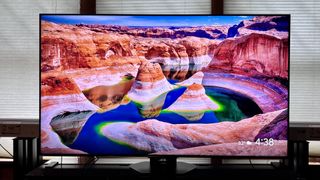
Specifications
Reasons to buy
Reasons to avoid
The Hisense U8N is a high-value TV that uses mini-LED backlight technology to deliver bright images with bold colors. It’s available in screen sizes ranging from 55 to 85 inches and has built-in 2.1.2-channel speakers with Dolby Atmos and DTS:X support. While it doesn’t provide the same extensive level of sound features as the Sony A80L and Sony Bravia 9 sitting at number 1 and number 3 in this list, respectively, it offers much better than average sound quality and even includes a built-in “subwoofer” to enhance bass.
In our Hisense U8N review, we said of the TV’s sound quality, “Dialogue was clear and full, and the built-in subwoofer made bass effects sound surprisingly weighty.” The TV’s two up-firing speakers also created an impressive sense of height when watching movies with Dolby Atmos soundtracks. We normally recommend adding a soundbar to a TV, but the U8N could easily go without one and still deliver sound that will satisfy most people.
Outside of its sound, the Hisense U8N is one of the brightest sets we’ve tested yet, and that capability plus its low-reflection screen make it a great option for both daytime TV and sports viewing. It uses the Google TV smart TV platform for streaming in the US (and Hisense’s own VIDAA smart TV platform in the UK and Australia) and supports the Dolby Vision, HDR10+, and HLG high dynamic range formats. Gaming features include two HDMI 2.1 ports with support for 4K 120Hz, VRR up to 144Hz (including FreeSync Premium Pro), ALLM, and Dolby Vision 4K gaming.
The Hisense U8N is an exceptional value and it improves on the last year's Hisense U8K – our previous mid-range pick – in almost every way, including sound quality. It even has an Auto Acoustic Tuning feature that uses the remote’s mic to adapt the sound to your viewing space. The U8N is a great choice if you have a tight budget and don’t want to spring for a soundbar when buying a TV.
Read our full Hisense U8N review
The best TV for sound: FAQs
How to choose the best TV for sound
If you're looking for the best TV for sound, first consider whether you need one. There are many more options available if you're willing to get a great-looking TV with mediocre sound and pair it with a soundbar or sound system instead.
However, if you have your heart set on an all-in-one package like the TVs listed above, keep your eyes peeled for a few key specifications. For example, power is important when it comes to sound. We've listed this as the number of Watts under each TV. The higher the number, the more powerful the sound. Granted, the best sound isn't always the most powerful, but it's a good indication as to whether you're going to get an immersive room-filling sound from your new TV.
The number of built-in speakers matters, too. Many TVs have 2 speakers, but the more you have, the more wide and expansive the soundstage will be. For example, the Panasonic MZ2000 in our list above has a 5.1.2ch speaker system for a fuller-sounding experience.
Although sound is a priority, don't overlook other important factors, too. Ensure that the picture quality is going to work well in your living room. For example, some TVs work better in bright light environments than others. And, of course, be sure to measure your space first to check you have room for your new display.
What's the best sound quality in a TV?
DTS:X and Dolby Atmos are the main home cinema audio formats. These rival technologies are both audio compression technologies that create a surround sound effect both in cinemas and in the home.
So which is better? Opinion is divided. DTS:X is encoded in a higher bitrate so should technically be better quality audio. But Atmos claims to be more advanced, and capable of producing a higher quality sound at a lower bitrate. As is often the case, it comes down to personal taste.
Atmos is more widely supported – by Netflix and Amazon Prime Video, among others – and most modern TVs are compatible with it, whereas DTS:X requires a separate audio system.
Read more in our DTS:X vs Dolby Atmos vs DTS Play-Fi guide.
How we test the best TVs for sound
How we test the best TVs for sound
Why you can trust TechRadar
To test the best TVs for sound, we watched a range of content on each of these displays, really listening out for some key criteria. This mostly included how the audio formats DTS:X and Dolby Atmos performed. Did they give the experience of surround sound? What was lacking? Did settings need to be adjusted considerably to get the desired effect? Did the TV deliver on the power listed in the specs?
In our reviews above, we've answered the key questions you'll need to know when considering the best TVs for sound, ensuring we tried TV shows, movies and games to let you know which might be better suited for certain kinds of content.
Although this guide is very much focused on audio specs, no one wants a TV that sounds great and looks mediocre. That's why every TV on this list has also been tested against the criteria we apply to all of our TV buying guides.
This includes rating picture quality, clarity and brightness. It also involves testing smart features, assistants and checking all of the best streaming apps work well. As well as living with the TV for some time, ensuring that all content types display well, viewing angles are good for a range of environments and much more.
We've tested hundreds of TVs over the years, which means you're in safe hands. Not only are we well equipped to pick the best TVs for sound, we also have extensive experience of the market as a whole, so can confidently select the TVs that deliver rather than relying on their specs.
Latest updates to this guide
August 15, 2024
Replaced Hisense U8K with newer Hisense U8N model as 'best midrange.'
June 18, 2024
Replaced Samsung S95C OLED with the Sony Bravia 9 mini-LED as 'best premium US.'
February 5, 2024
Added the Sony A80L as 'best tv for sound for most people'. Panasonic MZ2000 and Samsung S95C were introduced as 'best premium UK' and 'best premium US' respectively. Hisense U8K added as 'best mid range TV for sound'. Removed Sony X90J, Samsung Q80B, LG C2, Philips OLED+936 and Sony A95K from guide, mostly due to receding stock.
Get daily insight, inspiration and deals in your inbox
Sign up for breaking news, reviews, opinion, top tech deals, and more.

Al Griffin has been writing about and reviewing A/V tech since the days LaserDiscs roamed the earth, and was previously the editor of Sound & Vision magazine.
When not reviewing the latest and greatest gear or watching movies at home, he can usually be found out and about on a bike.
- Joe Svetlik
- James DavidsonTV Hardware Staff Writer, Home Entertainment
- Michelle Rae UyContributor